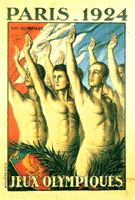HISTORY OF THE MODERN OLYMPICS
Paris, France, 1924
 |
| Olympic posters from the Archives, Olympic Museum Lausanne, from the book The Olympic Spirit, published by Tehabi Books |
The Finnish team, led by Paavo Nurmi and Ville Ritola, dominated the distance swimming races. For the first time, the swimming competition attracted as much attention as track-and-field. The men's events featured a rare collection of talent, including the Kahanamoku brothers and Clarence "Buster" Crabbe of the United States, Andrew "Boy" Charlton of Australia, Yoshiyuki Tsuruta of Japan, and Arne Borg of Sweden. The star of the competition, however, was American Johnny Weissmuller, who won three gold medals and a bronze medal as a member of the water polo team.
Helen Wills of the United States won gold medals in the singles and doubles tennis events. After the 1924 Games, tennis was dropped from Olympic competition because of questions over the amateur standing of many participants. The sport returned to the Olympics in 1988.
Introduction * Early History * Revival of the Olympics * Organization of the Modern Games